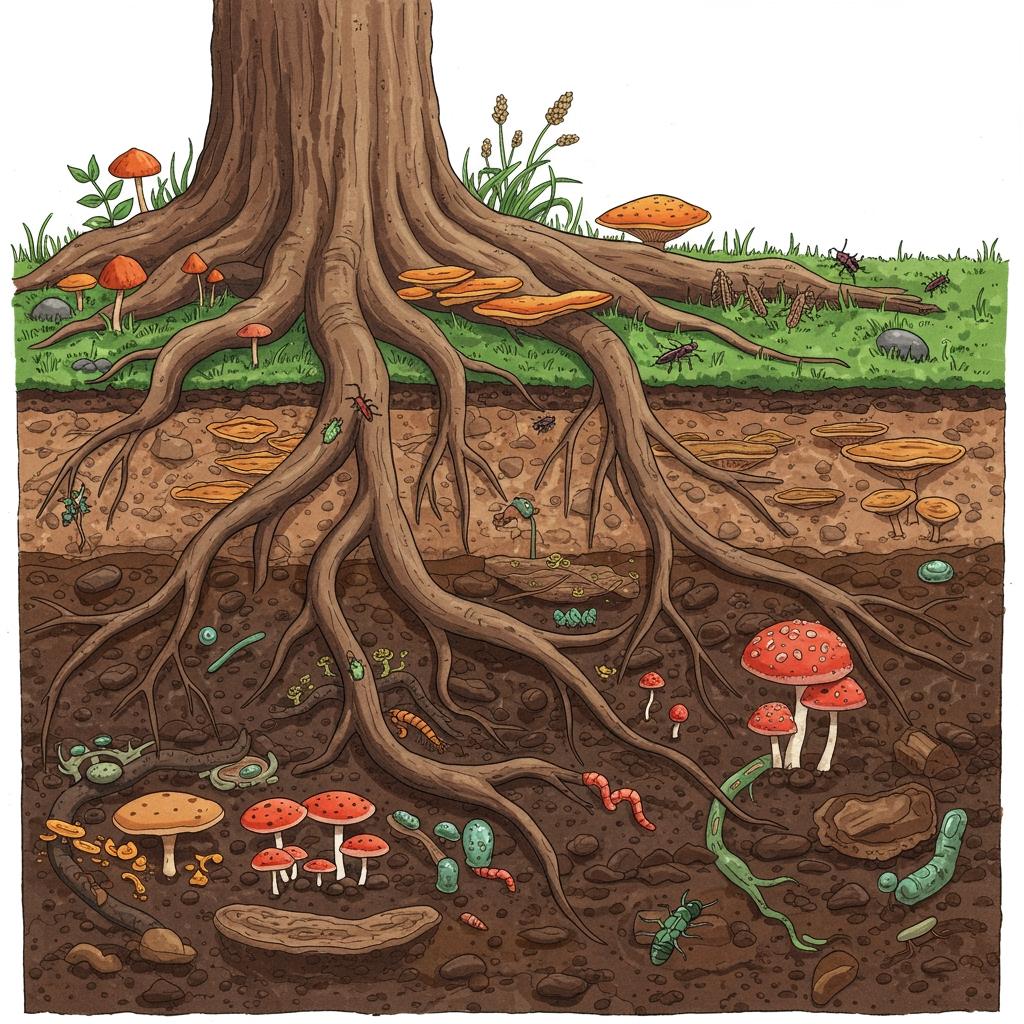How Fungi Communicate Through the ‘Wood-Wide Web’
 The ‘Wood-Wide Web’ connects trees underground through fungal networks, enabling communication and nutrient sharing across forests.
The ‘Wood-Wide Web’ connects trees underground through fungal networks, enabling communication and nutrient sharing across forests.
How Fungi Communicate Through the ‘Wood-Wide Web’
Discover the secret underground network that links trees like never before
By Peter Teoh, Science Writer
Imagine a secret internet beneath the forest floor, where trees send messages, share food, and warn each other about dangers. This isn’t science fiction—it’s the fascinating reality of the Wood-Wide Web, an underground network of fungi connecting trees and plants in forests worldwide.
What is the Wood-Wide Web?
For a long time, forests were seen as groups of individual trees competing for sunlight, water, and nutrients. But scientists have discovered that many trees are actually connected underground by a vast network of fungi called mycorrhizal fungi. This network is so extensive and intricate that it’s been nicknamed the “Wood-Wide Web,” similar to the World Wide Web of the internet.
Mycorrhizal fungi live in partnership with tree roots. They extend tiny thread-like structures called hyphae far into the soil, connecting the roots of different trees—even those of different species. Through these connections, trees can exchange nutrients like carbon, nitrogen, and water.
How Do Fungi Connect Trees?
There are two main types of mycorrhizal fungi involved:
-
Ectomycorrhizal fungi mostly partner with trees like pines, firs, and oaks found in cooler forests. They form a sheath around tree roots and weave between root cells.
-
Arbuscular mycorrhizal fungi are common in tropical forests and many crops. They penetrate the root cells themselves, creating tiny structures called arbuscules that help nutrient exchange.
These fungal networks act like underground highways, allowing trees to send resources and information back and forth.
Communication and Cooperation
The Wood-Wide Web isn’t just for sharing nutrients—it’s also a communication system. When a tree is attacked by pests or diseases, it releases chemical signals into the soil. These signals travel through the fungal network to nearby trees, which then prepare their own defenses by producing protective chemicals. This early warning system helps the entire forest survive.
Older, larger trees, sometimes called “mother trees,” use the network to send extra nutrients to younger or weaker trees, helping them grow. This cooperation boosts the health and resilience of the whole forest.
Interestingly, some trees can even use the network to defend their territory. For example, walnut trees release a toxic chemical called juglone through the fungi to inhibit the growth of competing plants nearby.
The Science Behind the Discovery
Dr. Suzanne Simard, a leading forest ecologist, has been a pioneer in uncovering the Wood-Wide Web’s secrets. Her research in North American forests showed that trees are not isolated individuals but part of a connected community, sharing resources and information through fungi.
Recent studies have mapped these fungal networks on a global scale, revealing how different climates influence the types of fungi dominating the networks. In cooler forests, ectomycorrhizal fungi create larger, more interconnected webs, while tropical forests mostly rely on arbuscular fungi, which form smaller, more localized networks.
What We Still Don’t Know
Despite these exciting discoveries, many mysteries remain. For example, scientists found a stump of a Kauri tree in New Zealand kept alive by its neighbors through the fungal network long after it lost its leaves. Why the other trees help sustain a dead stump is still unclear.
Also, while the idea that fungal networks always help seedlings grow better is popular, research shows mixed results. Sometimes seedlings benefit from being connected; other times, it makes no difference or even harms growth. This complexity means scientists are still unraveling how exactly the Wood-Wide Web works in different environments.
Why It Matters
Understanding the Wood-Wide Web changes how we think about forests. Rather than just a collection of individual trees, forests are communities that communicate and cooperate underground. This knowledge helps us protect forests better, especially as climate change and deforestation threaten these vital ecosystems.
So next time you walk in the woods, remember: beneath your feet lies a bustling, invisible network—trees chatting, sharing, and supporting each other through the incredible Wood-Wide Web.
Side Notes
- Mycorrhizae means “fungus roots” in Greek.
- Trees can live for hundreds or thousands of years partly because of these fungal partnerships.
- The Wood-Wide Web also involves bacteria and other microbes, making it even more complex.
Trending Sidebar
- Scientists use computer models and soil sampling to map fungal networks globally.
- New technology lets researchers “listen” to electrical signals in fungi.
- Conservation efforts increasingly consider protecting fungal networks, not just trees.
- Some researchers are exploring how the Wood-Wide Web might inspire new communication technologies.
Explore more about the hidden lives of forests and how science is revealing a world beneath our feet!